Every great adventure starts, and finishes, with a sketchy mini-bus ride.
This so far has been my understanding of adventures in Bolivia.
Last weekend, we retreated to Sorata for a photography project, as we had been told that both the people and scenery there are beautiful.
We climbed the streets to Buenos Aires to catch a bus brandishing the “Sorata” sign. Busing or minibusing to destinations is the main mode of mobility here in La Paz, for Cholitas with their sacks of who knows what [shel silverstein-children] and tourists tight on cash. It takes three hours to get to Oruro, one of La Paz’s neighboring departments, while traveling to Santa Cruz, the Eastern most and largest, takes over 24 hours. Nevertheless, buses still go there, and the fare is considerably cheap.

Sorata is right near Lago Titicaca.
I’m learning not to make the mistake that my friends and I will have the entire mini bus to ourselves. Each seats 9-15 people depending on how tight you pack it, and drivers will most definitely always pack it tight, even if it means shouting at the window at potential passengers, waiting around until it fills, or making numerous stops to pick up or drop people off at their respective destinations.
I was grateful that I was crammed in the back between two of my friends rather than a crying baby and smelly Cholita. As we descended about 2000 feet into the multi-biomic region that is Sorata, passengers began to leave, sometimes in places that seemed desolate and remote, which opened my eyes to the striking simplicity of life for some of the people here. People get off the bus in the complete darkness, swing their sacks over their backs, and disappear into the velvet black of the unlit road.
We got out of the minibus on a crowded road where all the buses drop off their travelers. After a month of confinement, my toes enjoyed the air reminiscent of Long Beach’s summer evenings, as we stepped over puddles in the grooves on the imperfect cobblestone streets lit by dim streetlights and convenient stores. The town was obviously small even at night, and walking there was a nice break from nearly getting debilitated by a taxi or bus in the streets of La Paz.
Our hostel was called Mirador, and it was an earthy little hostel overlooking, at that time, pitch black that we knew would turn into an incredible view the next morning, just because of the feel in the air. It had dream catchers and tapestries hanging around the area and reminded me of a beachy hotel california. I shared a room with a bed and nightstand and a key dangling with another dream catcher with my friend. For my first hostel, this was a privilege, as hostels are generally a single room with about ten bunk beds and a colorful array travelers with an equally colorful variety of smells and sleeping patterns.
A walk out at night would reveal restaurants with a greater variety of vegetarian options and cheaper prices, at which we had egg sandwiches, a pretty common “delicacy” sold anywhere from official restaurants to businesses with nothing but bread and cardboard signs.
We awoke early the next day and dressed to meet the president, as we were notified that he would be visiting the small town to check on the city’s construction progress and through that, further his campaign. Signs that read: “SORATA SUPPORTS EVO” were strung across the city, some dangling with stuffed animals and festive decorations.
People were already preparing, vendors were out and people were working along the sides of the streets. Women were holding campaign signs and those in opposition were setting up their own. We found the football field where Morales was scheduled to visit, and became acquainted with a few of the people in charge including a man organizing the event, who made an appoint to arrange the army in an appealing formation when we expressed interest in taking photos of a few of them.
While some Bolivians wish that we go back to our country while we buy things from their stores, walk in their streets and take photos of their gorgeous country, some absolutely love it. This troupe of soldiers basically waited in line to take pictures of and with us, in multiple different combinations, followed by asking us where our hostel was so they could come see us later.
The field slowly filled with people, mainly workers’ unions and indigenous groups holding signs, cohesive not only by their closeness but also the wide array of bright colors they wore on their hats or shawls. Not only was the field filled with excited Soratans, but the bleachers behind the fence were filled as well, Cholitas with children on their backs, munching snacks from bags and men knelt in groups awaiting word of the president’s arrival. Some said he was to arrive via helicopter, some said that he was in the black SUV with tinted windows, Bolivian flags blowing in the wind along each side. Instead, he was walking down the dirt decline to the field, officers surrounding him, militia men guarding him, and the colorful locals streaming behind, increasing their speed to catch up and catch a glimpse or a wave.
Multiple people introduced him on stage, some speaking in Aymara, some in spanish, but all hailing him as if he were a god, saying “Ja ya ya Evo!” between phrases. When he came to the stage, he was adorned with necklaces made of flowers, fruits and vegetables native to the Andes region. He sat surrounded by his supporters on the stage as people spoke, whispering to his colleagues and at one point, point to my blonde friend and I, as if to comment on our out-of-place-ness.
Our assignment was to catch the reactions of those who were expecting the president, so rather than listening to the content of the speeches I was running about and capturing the awe-struck, anticipatory and concentrated faces of those in the crowd. These are the best of the bunch:
While I didn’t pay much attention to the speeches, they all seemed to be in worship of the president, and the “visit” seemed to be more of a sermon with many guest speakers than a presidential address. There was no direct campaign speech from the president whatsoever, just his sitting and enjoying the praise. There was mostly support from indigenous groups, as Morales was originally a Coca farmer, “The face of change” that appeared all over Bolivia, elected into office for his support for the indigenous population. Groups of construction workers, mechanics and other unions stood with signs in support, some stepping up on stage to say a few private words to the president and gift him with flowers or cover him with confetti.
The second half of our day was set aside for a long hike, 8 miles in 3 hours, to La Gruta de San Pedro, a cave with an underground lake. The hike was gorgeous, the perfect manifestation of our escape from the city for a few days; we walked through tropical forest, over a river and plunged into the canyon via a windy road that we could see from our hostel.
While catered to tourists as most places are, Sorata is quite untouched compared to the beautiful areas of Bolivia; while some restaurants lined the beginning of the trail there were mostly convenient stores for locals’ benefit and homes scattered along the rolling hills or grassy meadows on either side. Our futbol-loving friend spotted a clan of kids playing a game on their family’s property as parents and elder siblings watched, so we climbed onto the field and joined.
Yeah, it was pretty much like the movies. Groups of kids, first timid, later clung to our legs and ran after us as we zigzagged the grass, chasing the under-inflated ball. The air was warm and the scene reflected it, the sun bringing the brightest green out of each blade of grass. Chickens clucked and dogs laid on the sides of the misshapen field. It was Chicos vs. Chicas, and the girls won. When we left, the girls followed us to the edge of the property, begging for us to return and wishing they could come with.
We continued, being passed by taxis that bring those who don’t want to journey by foot to the cave. Some families or young people carrying buckets and bags were walking in the other direction; the length of the daily journey for some people to work or feed their families is humbling. We came across a frail man with a multi-gallon tank full of water. He was attempting to sling over his shoulder a thin rope attached to its handle. His eyes were glazed over and his skin was leathery and aged from years of labor. He asked us to help him place the load on his shoulder so that he could continue walking, but our friend helped him carry it a ways and down a hill to his home, which had been deprived of water as the city was using dynamite to dismantle the side of the hill, for reasons we didn’t understand.
Across the scale, there is an astounding disregard by the government of peoples who live secluded in this way, and Bolivia is like a look through the magnifying glass at this issue. It sometimes makes me wonder if they prefer to live isolated from the hustle and bustle, or if they have no choice. Around Bolivia one sees many unfinished houses-missing ceilings, windows, walls, etc, that are lived in. This is because the property law here differs from elsewhere, and if a residence is incomplete, property taxes need not be paid.
We were almost there, and quite hurried as the workers above were yelling for us to get out of the way of the explosion. When we arrived to the entrance of the cave, it was a lot more claimed upon than I had hoped, and they were asking admission. After looking us up and down, he asked 20B from tourists and 10B from Bolivians, which my American friend who had been born in Bolivia (yet speaks no spanish) was admitted for the color of her glowing dark skin.
The humidity increased significantly as we descended into the cave, and it was much less touched than commercialized natural attractions in the U.S., as the only addition to the cave was lightbulbs to light the path and some stairs for safe descent. A narrow passageway gave way to a bigger cavern, its ceilings limitless. We were using stalagmites as handrails as stalactites hung over our heads (nope, I didn’t mix those up, I just checked). In the heart of the cave was a lake that was so clear and still that it appeared to be a giant hole giving way to another level of the cave. The water was perfectly clear and in the heat of the cavern, a swim was extremely enticing but prohibited. The monopolizers of the natural phenomenon gave boat rides for 5B.
Somewhere in between, there’s a couple sketchy taxi rides as well. It was too late and we were too drained to walk another 8 miles back, so we hailed a couple of taxis. They told us vaguely that we had to travel a ways around the curvy trail to the cars that would be driving us, due to the debris-blocked road from the explosion. After climbing over debris, we came upon our ride, which was out of gas. After waiting a bit, we crammed two too many people into the taxi and headed back to town. The ride felt like Disneyland’s Indiana Jones. There were parts when it looked like his turn wouldn’t be sharp enough, and we would plummet off the side of the cliff, and bumps so big that we would hit our heads on the roof. And it wasn’t just the condition of the road, he was driving really fast and really recklessly, causing his random rainbow of knickknacks by the windshield to sway back and forth over the furry dashboard. I had a good time, but it seemed that everyone else was terrified.
We had another quiet evening with the Bolivian 20B three-course meal and wine in the tranquil, lukewarm darkness.
During the last hour of my stay in Sorata, I saw one of the most beautiful scenes of the movie that is life through my own eyes. I’ll try to describe it, but I don’t think my words will give it justice. It was about 8 am and the gray skies had not yet burned off. The morning bustle was the same as the every day, markets opening and people walking up and down the streets with sack loads of products to be sold. The chitter-chatter between my friends and I faded away, and at that instant, the activity along the sidewalks slowed. The only sound was that of little feet pounding on the stone streets, and we all watched silently as Sorata’s mascot, a young boy with a toy bow-and-arrow who I had repeatedly spotted around town, came running, momentum maintaining his speed, his wispy hair rustling like wild grass. He wore a simple T-shirt and cargo shorts with flip flops, and from whatever he was running, he gripped his bow-and-arrow with a liberated expression on his face as if it was all he needed.
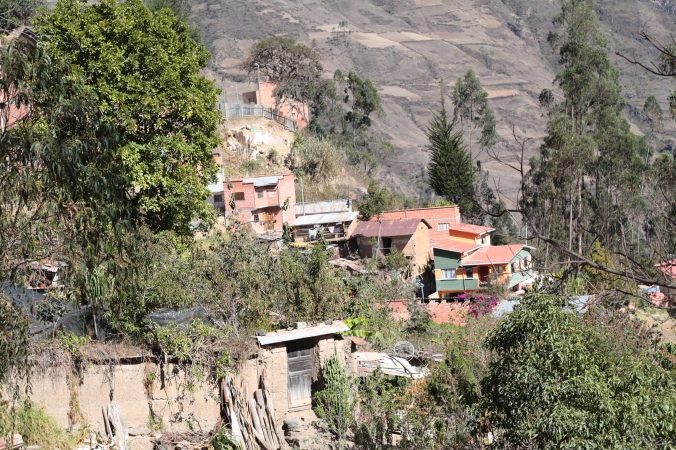
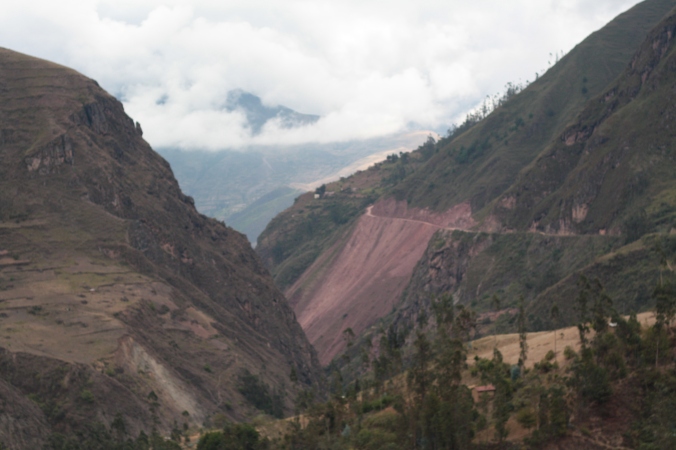
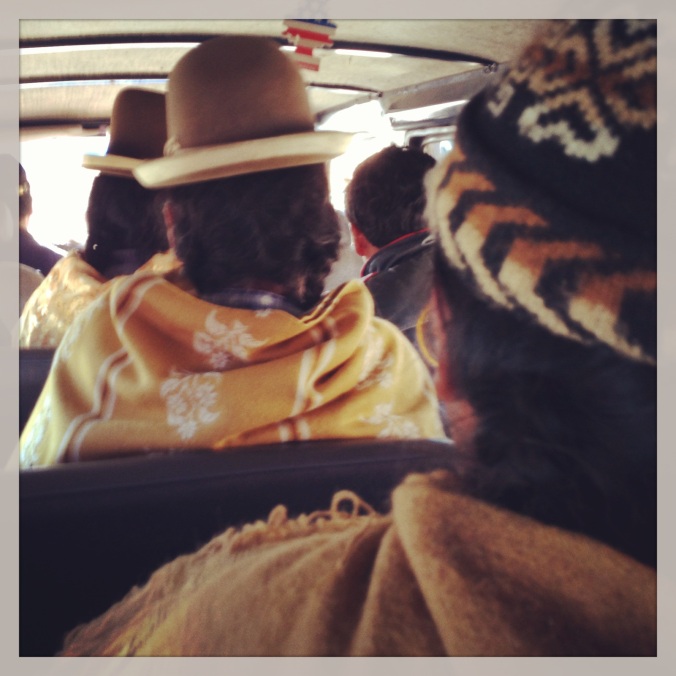
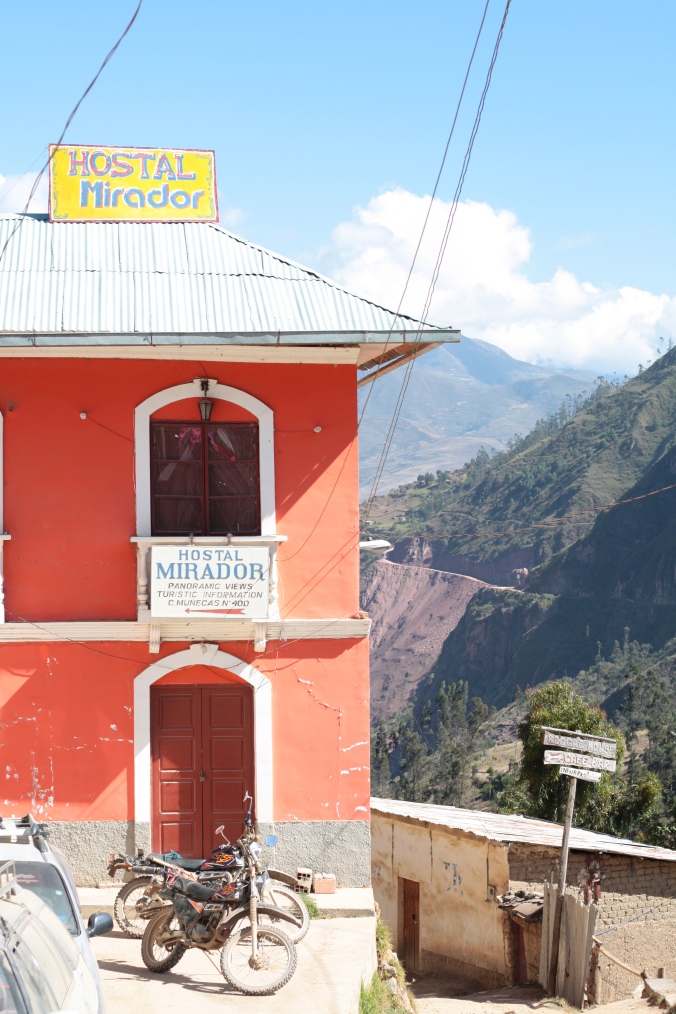
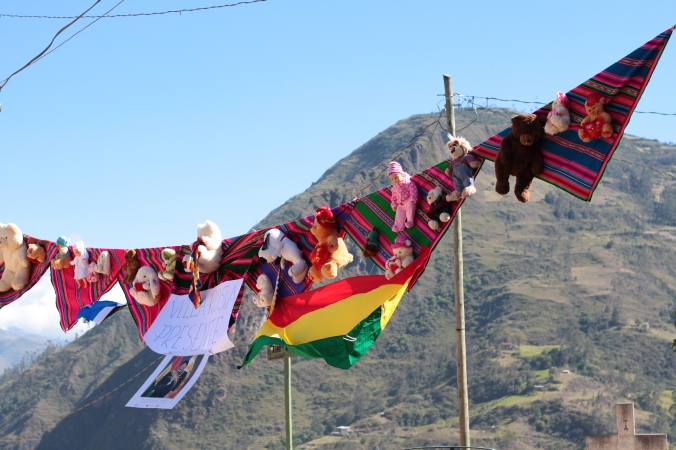
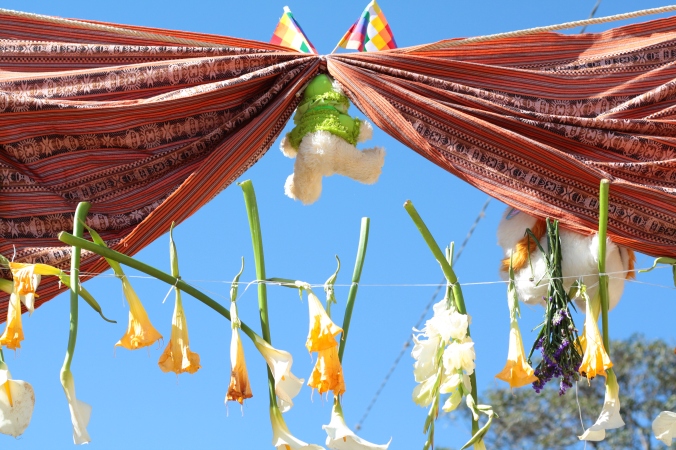
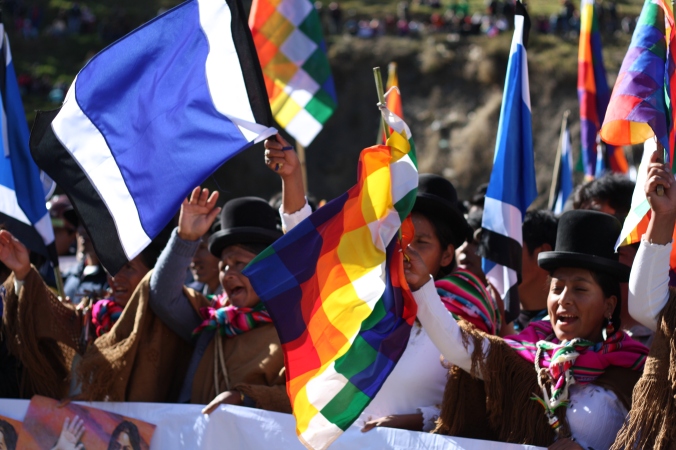

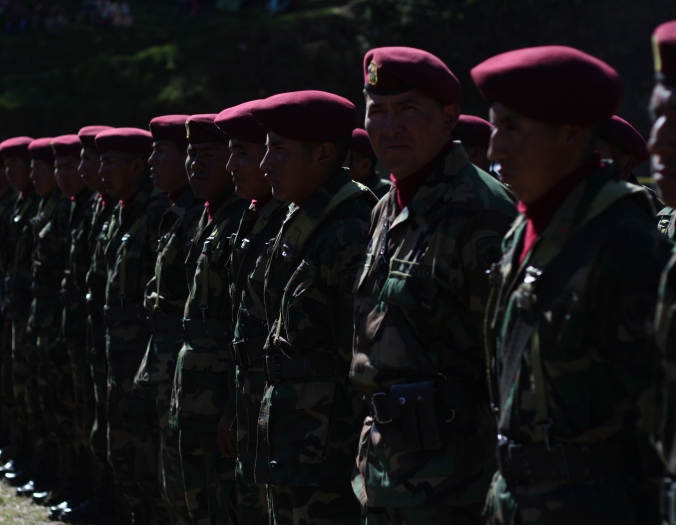



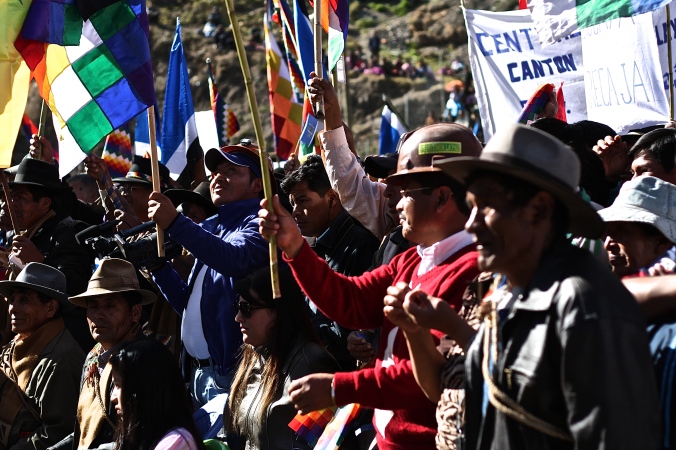
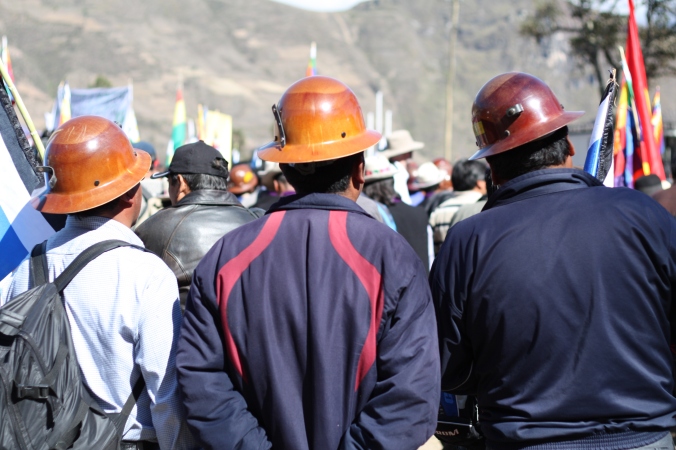




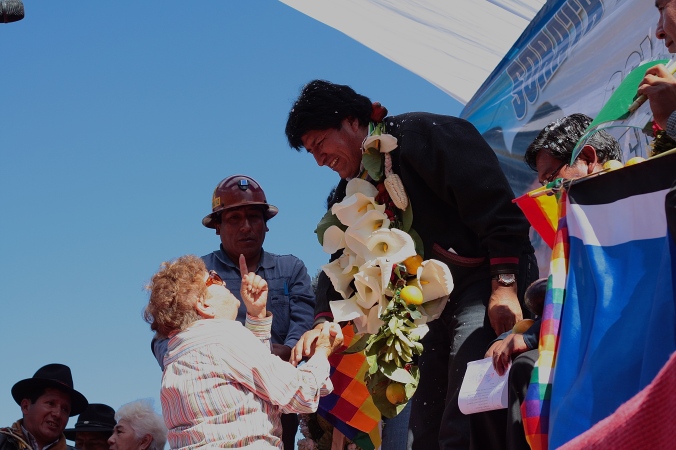
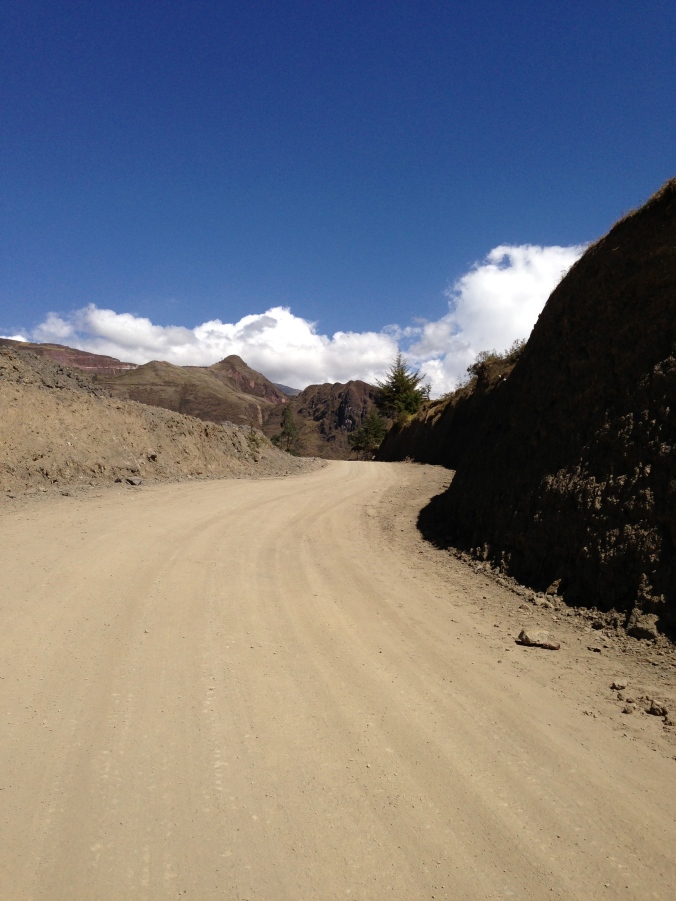
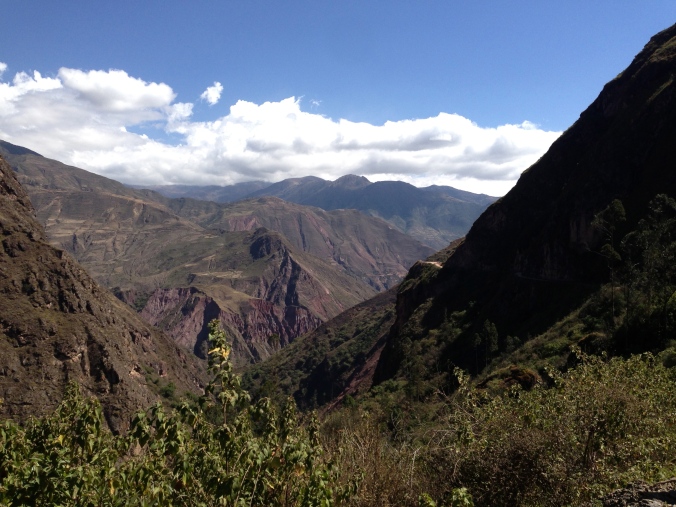


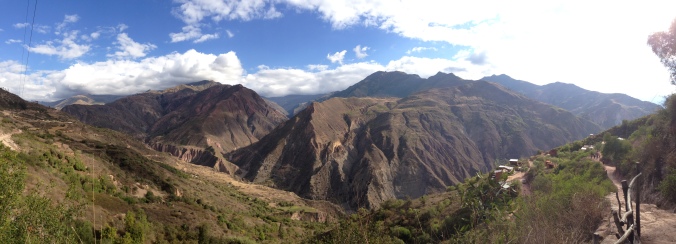
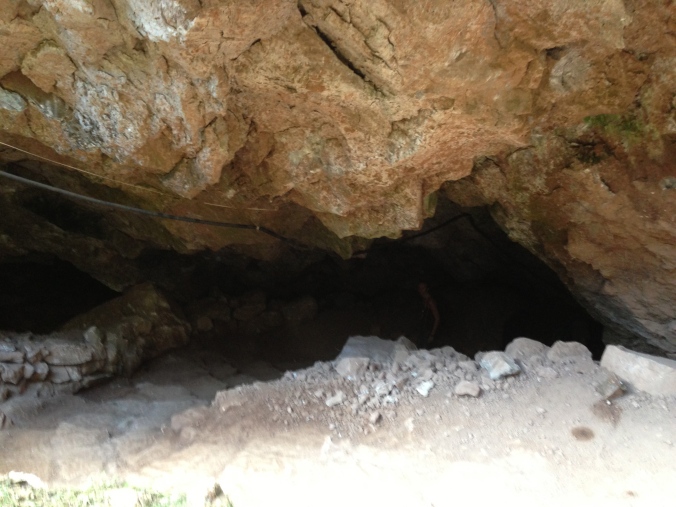
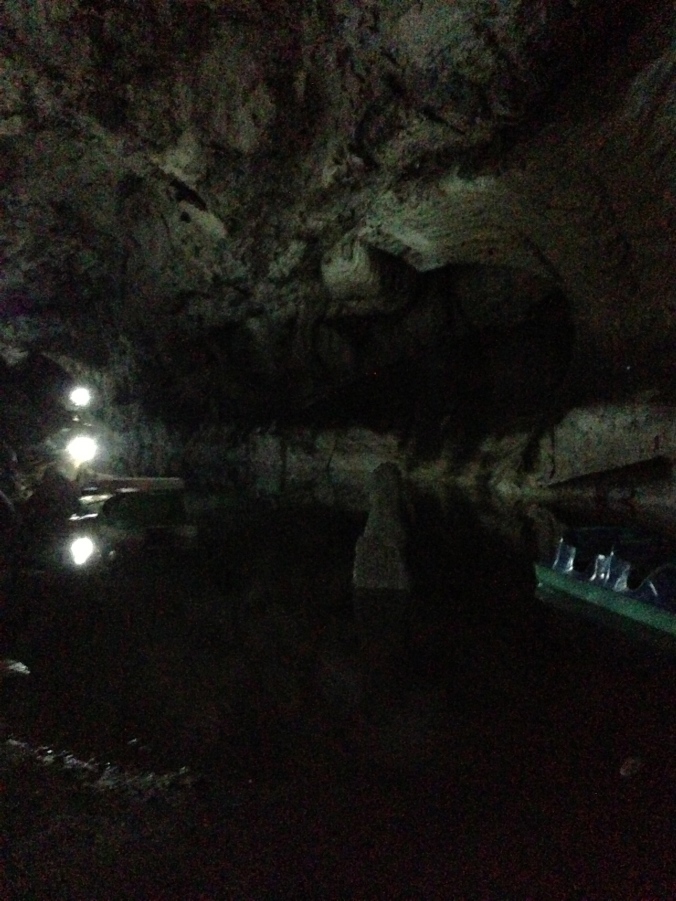
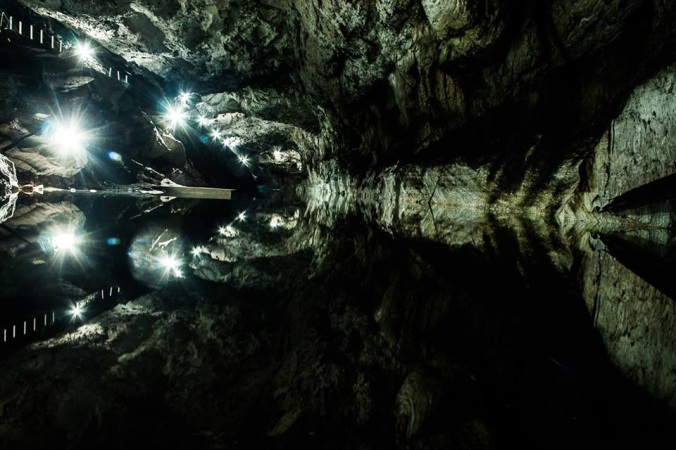
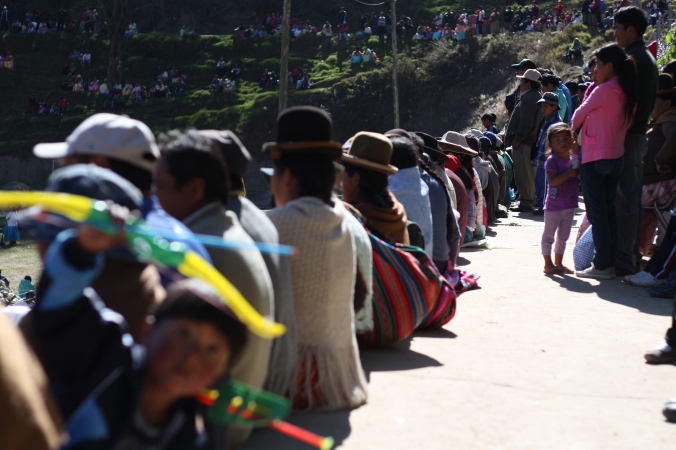
Again, the pride of these people is evident in your description of them…the buses sound scary as does the taxi driver, but Sorata looks beautiful. I love the different colors in their architecture…how fun to join it for a football game! I can picture the children running after you as you were leaving! They probably don’t get many visitors. The cave sounds awesome, the boys would love that, I bet. Too bad you could not swim! It was hard for me to see the pics, I will have to get a better look when you get back. So the people do not finish their homes to avoid tax? In your last paragraph I was waiting for you to say who was chasing the boy!
Hi sweetheart. Thanks for your wonderful description of their country as you hiked through and encountered children at play. The very first photo showed a cloud formation with a beautiful image of a large eagle between the peaks.
You captured the bright and varied colors along your itinerary and I can almost feel the warmth as you descended into the cave’s interior. A swim would have been nice (and made your brothers jealous). What do they use for money (5B, 10B)? Sayonara, or is it Chao (wrong country) Hasta La Vista baby.